A tale of two tanks
A tale of two tanks
Ahalya S Bhat does an evaluation about water conservation efforts being undertaken by different NGOs in Bangalore.
Deccan Herald
The Tank revival mission, a highly commendable state level effort supported by all stake holders and neighbourhoods, interested in 'water conservation has passed several rough routes. Seeing pictures of hundreds of large dead fish floating in the Ulsoor tank, a tank that not only took time, money and effort to revitalise, but when revitalised, was truly a joy to see whether one was driving along side or walking.
Similarly, the revitalisation of the Sankey Tank was welcomed by residents of Malleswaram, Sadashivanagar and also campuses of the Indian Institute of Science, Raman Research Institute, National Institute of Advanced Studies.
The beautification of the tank between 2002-04 was an important step in sustaining the tank. Storm water drains, which feed the tank, had been clogged and sides of the tank were dirty.
The two neighbours of the tank on the west and north were about the nursery prepared by the Forest Department and the plantations further in, and the other, the magnificent botanical sanctuary being maintained by the public charitable trust in the name of Smt Singamma Sreenivasan. This Trust owns land on the north side of the tank, which has been converted into a garden having a variety of about 200 species and 500 trees.
It also contains plots with endangered species of medicinal plants and high value medicinal and aromatic plants. It is a biodiversity conservatory much acclaimed by eminent botanists like Dr M S Swaminathan, who inaugurated the parks as well as the late Dr Raja Ramanna who was also a patron. The 50 year-old garden is one of the highlights of Bangalore. Late Sir C V Raman would take his walks in this park before he built the Raman Institute and at least 10 per cent of the plant variety in the Raman Institute gardens have come from the Foundation's garden. Earlier designs that would disturb the calm of the Sankey Tank, like the presence of water birds and two sides surrounded by mini forests, were stopped since many officials and architects did not have a historical understanding of the tank’s ecology. Channels that brought in water were cleaned, so that they may keep its perennial water level.
Understanding was shared on how during dry seasons, especially if there were consecutive years of low rainfall, the tank dried up rapidly and therefore needed to be nurtured carefully. Thus, the idea of emptying the tank for desilting was stopped, as once the tank was emptied, rejuvenating it with rain water would often take 5-6 years and a dry tank bed is usually quickly taken over by builders, as can be seen in the case of the old Miller's tank.
The Forest Department nursery adjoining the west side of the tank was shifted to provide seating space and three apartment towers whose servicing would drain the underwater of the tank was also stopped. But unlike the famous poem written on a river,“that men may come and men may go, but I go on for ever,” the coming and going of the officials of the BMP - has led to a reversal of the values that were brought in revitalising the Sankey Tank.
Clean storm witer drains, which has been supplying water for 50 years from the Sadashivanagar police station and upwards, is being blocked by a strange initiative and made into a footpath. The footpath on its east is being built along a 20-foot drop, where a landslide is likely and since it is at the lowest level of the tank bed, it is likely not only to be inundated with water, but also become a swamp during the rainy season. Protective fencing that prevented walkers from falling 12 feet on the north side of the tank have also been removed and rare plants and tree plantations destroyed. For further enquiries, write to Ahalya Bhat, Associative Director at ssfb@giasbg01.vsnl.net












